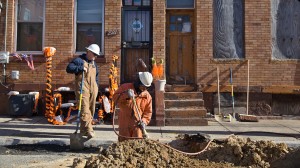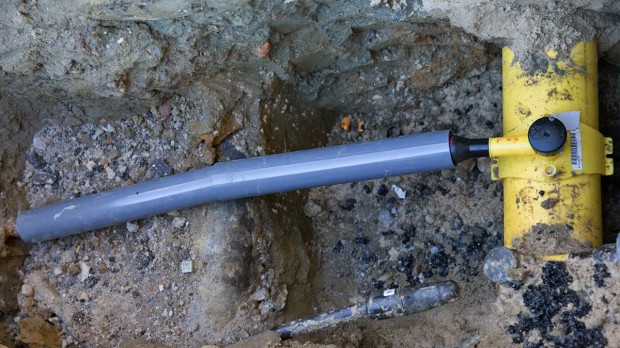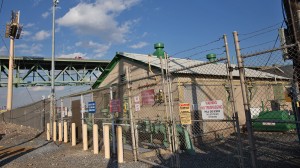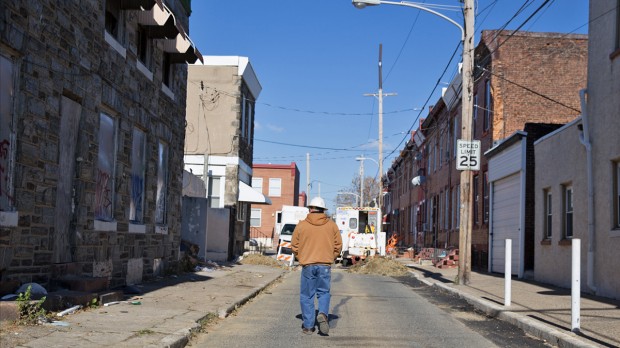Leaking city gas pipes pose climate hazard
-
Susan Phillips

Kevin McDonald, PGW Senior Pipe Mechanic uses a compressor to back fill soil covering main and service pipelines in North Philadelphia.
Philadelphia has some of the leakiest natural gas distribution pipes in the nation.
This comes with an environmental cost, because natural gas is primarily made up of methane, a powerful greenhouse gas.
Methane emissions are getting more attention from climate scientists, environmentalists and policy makers because they actually have a much more immediate impact on global warming than the greenhouse gas that gets the most ink, carbon dioxide.
Philadelphia’s recent failure to close a deal to sell the city-owned Philadelphia Gas Works to a private company means those leaks will continue to get fixed at a snail’s pace.
At current estimates many of us will be dead before all that leak prone pipe beneath city streets is replaced.
Miles and miles of leaks
Philadelphia’s natural gas infrastructure resembles that in other older industrial cities on the Eastern Seaboard.
Interstate transmission pipelines feed natural gas from well heads on the Gulf Coast, or Marcellus Shale to nine separate “city gates.” At these city gates, the high pressure gas, which comes in at 800 pounds per square inch, gets transformed into low pressure gas. By the time the gas gets to your stove, it’s about one-quarter pound per square inch.
In Philadelphia, the city gates feed natural gas into 6,000 miles of pipe that run beneath city streets. The “mains” are the pipelines that run along streets, while the “service lines” connect to houses and businesses. About 1,500 miles of main – a quarter of the total – are made of cast iron, some of it dating back to the 1890’s.

Philadelphia Gas Works crew members activate new plastic main lines (right) and service lines in North Philadelphia as part of an ongoing program to replace the aging cast-iron pipelines throughout the city. The old cast iron main can be seen beneath the new, grey plastic service line.
Cast iron is problematic. It’s strong but inflexible. Joints leak. Countless freeze-thaw cycles cause the cast iron to crack. Heavy trucks rumbling on top can make a pipe give way.
When the lines were installed, the natural gas running through them was wetter, and more suitable to cast iron.
Bare-steel pipe is also prone to leak because it rusts. Some steel pipe has a small electric current running through it, which prevents rust. This is called “cathodized steel.” Today, PGW is replacing its older cast iron and bare steel pipe with the more state-of-the-art plastic pipe. It costs an estimated $1 million to fix each mile of pipe. By PGW’s estimates, at the current replacement rate, today’s leak prone pipes, which includes both cast iron and bare steel, won’t be fully replaced by the year 2102.
A pressing climate threat
Environmentalists and climate scientists have started sounding an alarm about methane leaks. A lot of attention is now on the oil and gas industry to reduce methane emissions at the wellhead.
When it comes to distribution lines, the utilities that operate them have long worried about leaks and kept track of them. But their focus has always been on safety, not emissions. Methane leaks can blow up houses, and cause manhole covers to shoot up into the air when the gas comes in contact with an electrical charge. For good reason, those that pose a hazard to life and property get priority. But low pressure, small leaks that don’t pose a big safety hazard can continue for decades.
Each year the utilities are required to report a tally of the leaks to the Department of Transportation. But the impact on the climate has not been clearly measured.

One of 9 Philadelphia Gas Works ‘gate stations’. The gate stations are entry points where natural gas is depressurized before being pumped into the PGW network of pipelines beneath the city streets.
The Environmental Defense Fund has recently teamed up with Google to map several city’s natural gas leaks. Steven Hamburg is the chief scientist with the Environmental Defense Fund.
“Methane is very potent,” said Hamburg. “It traps a lot of energy.”
Not only does it trap a lot of energy trying to escape the Earth, but its impact is more immediate than some other greenhouse gases.
“Methane is a very big influence on the rate of climate change that we’re experiencing now and over the next couple of decades,” said Hamburg. “So we have to reduce the emissions of methane so we can slow the pace of climate change.”
In fact, a methane leak’s warming impact over the next 20 years could be 84 times that of carbon dioxide, according to several estimates. And methane, which makes up the main component of natural gas, has been pouring out of cracks in our sidewalks and streets from those leaky pipes for decades.
But nobody knows how much. Pennsylvania’s Climate Impacts Assessment, published in October 2013, never mentions methane emissions from distribution lines. And there are no state, federal or local regulations on methane emissions.
Philadelphia’s office of sustainability does include the PGW leaks in the city’s carbon budget. It estimates the city’s miles of leak-prone pipe put into the air the greenhouse gas equivalent of 120,000 cars.
The Environmental Protection Agency is expected to issue a directive under the Clean Air Act to reduce methane emissions from oil and gas production. But distribution lines are not expected to be included.
Looking for dead trees
Two people who have made some headway on tracking and measuring the methane leaking from city streets are Boston University professor Nathan Phillips and a former gas worker named Bob Ackley.
Ackley spent 30 years detecting gas leaks for utilities in New England. When Ackley learned his trade, the first sign of gas leaks, was a dying tree.
“Most gas guys know that gas leaks kill vegetation,” said Ackley. “Sometimes it’s quick. But often it’s a slow process where gas leaks are there for years and years and slowly kills trees.”
Looking for dead trees, and using methane detectors, Ackley teamed up with professor Nathan Phillips after a chance encounter to map all of Boston’s leaks. They documented 3,356 points where the greenhouse gas was just rising into the atmosphere, helping to warm the planet. In Washington D.C., a similar survey mapped about 6,000 leaks.
“The gas leaks invade the soils and the root systems creating anoxic conditions which probably starve the roots of oxygen and the roots need oxygen in order to function,” said Phillips.
Phillips is a tree physiologist, and says there’s not much research about why gas leaks damage trees, shrubs and other vegetation. But he says although it’s been known to gas workers for decades, the general public was unaware of the connection.
“Until you see it mapped out, you don’t understand the extent of the problem,” said Phillips. “So the novelty of our project really was the map to show the problem, not to discover the problem. The problem has been known.”
Lost and unaccounted for gas

PGW area supervisor Carlos Rojas walks toward a work site where aging gas lines are being updated. Philadelphia plans to replace 1,500 miles of cast-iron pipelines in the city over 88 years.
One statistic known to people in the natural gas distribution business is “lost and unaccounted for gas” or LUAF. Every utility loses some amount of gas between receiving it at the transmission line, and delivering to the final customer. Each utility is required to report this each year to the Pipeline Hazardous Material and Safety Administration, which overseas pipelines under the Department of Transportation.
But utilities get to pass the cost of the lost gas onto customers, so the incentive to curb the losses is weak.
Several causes lead to lost gas. These include inaccurate metering, theft, and temperature and pressure changes. And, of course, leaky pipes.
Barry O’Sullivan, a spokesman for the Philadelphia Gas Works, says PGW has successfully reduced its rate of lost and unaccounted for gas to 2.7 percent. That’s within the normal range for utilities.
“It’s a tricky one, right?” said O’Sullivan. “So we know how much gas we buy. And we know how much gas gets delivered to the final customer. We know there’s a gap in that number. How much is being vented into the atmosphere, we don’t have a figure on that. But we know it’s not the majority of the gas when you factor in the other uses.”
Katherine Gajewski runs the office of sustainability. It’s her job to track the city’s greenhouse gas footprint. And she’d love to see it reduced.
“It’s a set of emissions without value, it’s energy that isn’t contributing to the economy.”
Gajewski says it’s frustrating not having the resources to replace the leaky pipes.
“Eighty eight years is a long time. I think its hard for any of us to look over the horizon of our lifetime and think that, man, by the time we leave this earth there still might be cast iron pipes leaking methane underneath the city.”
















